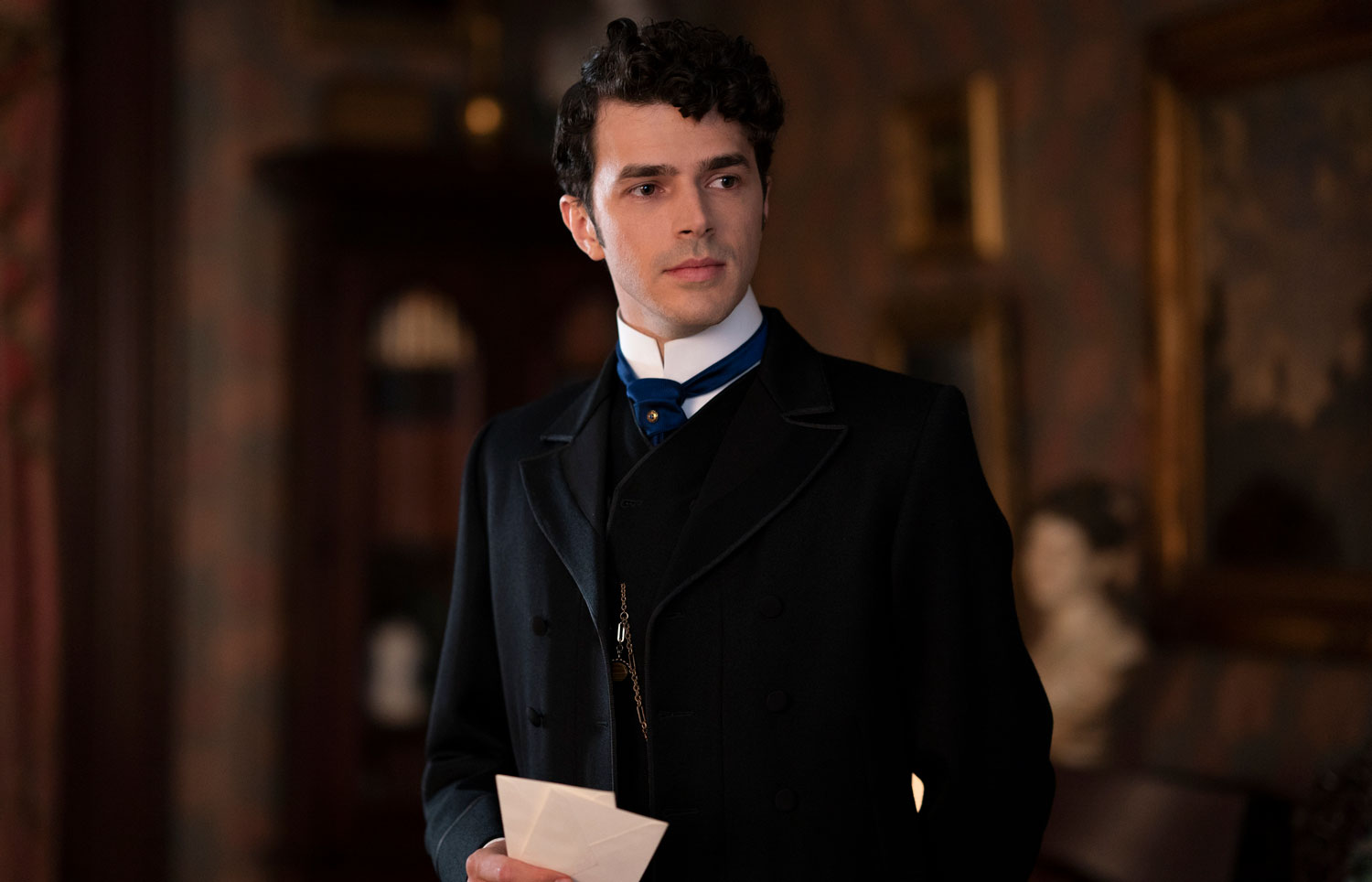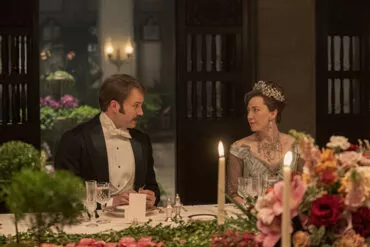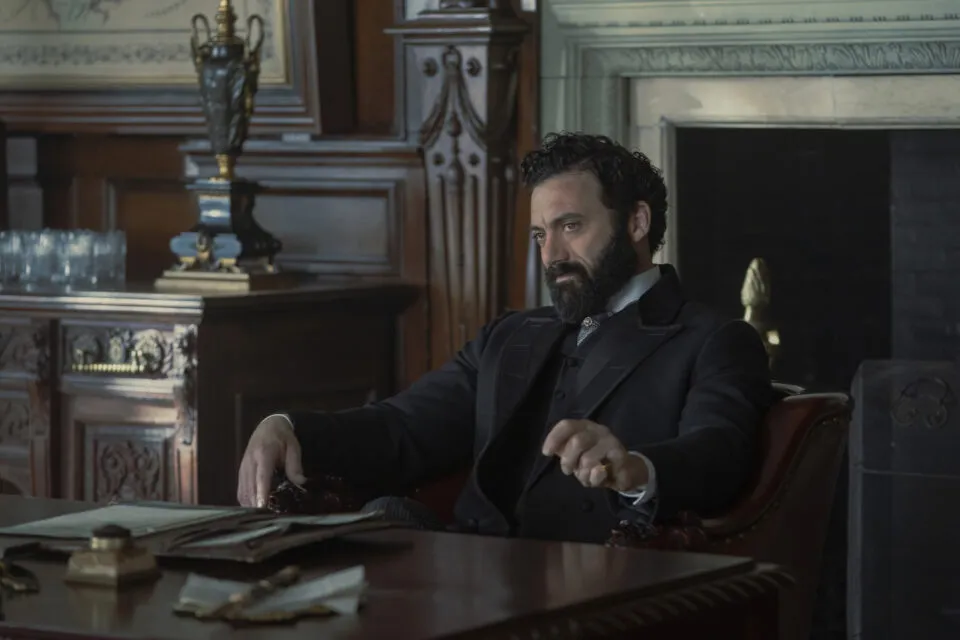Episode 9, “Let the Tournament Begin”
Marian’s grand plan is threatened. Bertha and Mrs. Astor lock horns over Gladys’ debut. Peggy is stunned by a major reveal.
In this Episode…
☞ The Elms is featured with the kitchen in the beginning of the show and then Mrs. Berwind’s Bedroom as Gladys’ bedroom.
☞ George Peabody Wetmore’s childhood bedroom suite at Chateau-sur-Mer again is used for Oscar Van Rhijn’s apartment (see Episode 3).
☞ Young “Carrie” Astor is disinvited to Gladys Russell’s ball, much like in real life when the daughter of Mrs. Astor was not invited to Alva Vanderbilt’s “fancy dress” ball in 1883.

☞ Larry Russell’s pursuit of an architecture degree in the Gilded Age: If he wants to be at the level of Stanford White, whom he claims as his inspiration, his journey will likely include more than study in America. Most young, aspiring architects had to travel to France and many to Italy to feel as though they were well equipped to understand the “principles” of classical architecture. Will he attend L’Ecole des Beaux-Arts?

☞ Henry Flagler was a man of great influence, and it’s no surprise he was invited to the debutante ball as he likely had vast business interests similar to Mr. Russell’s. Flagler was a founder of Standard Oil and of the Florida East Coast Railway, and was a major force in the development of Florida’s Atlantic Coast.
☞ The tradition of calling cards was one of formality and necessity during the Gilded Age in the upper classes. In the event someone was not home, it was known who stopped by. It was also a popular form of collecting as whom you received or who received you was considered a symbol of status.
☞ The Breakers Music Room is the scene of the coming-out ball for Gladys Russell. This baroque-style room, with its blue-gray marble, crystal chandeliers reflected in mirrors, and rich red and gold fabrics, gives the scene plenty of color, sparkle and glamour.

☞ When making introductions at the ball, they announced “Winthrop Chandler.” Possibly this was a reference to John Winthrop Chanler, a New York congressman who built the home in Newport that is now the Chanler at Cliff Walk, a hotel.
☞ During the ball reception, Glady Russell’s dress is a light purple, near mauve, a color that became popular a decade later in the 1890s. Its cut and composition are similar to that of Alva Vanderbilt’s dress in her 1875 portrait by Benjamin Curtis Porter.
☞ Adoption in the Gilded Age: As Peggy Scott learns her son was adopted, the history of adoption in the U.S. was not always a happy one. The 1851 Adoption of Children Act in Massachusetts was the first law to make sure that adoptions of children were appropriate and healthy as well as legal. While Peggy’s son is still in Philadelphia, we believe, this era was also a period when there were “orphan trains” that transported unwanted or orphaned children across the U.S. to adoptive families.
☞ Last scene: Finally, someone cleaning up the horse poop!

More Episode Guides

Deep Dive into the Show
Learn about the people, places and events depicted in Julian Fellowes' popular historical drama series.

Season 1/Episode 1, "Never the New"
In 1882, Marian arrives at the home of her “old money” aunts Agnes and Ada, whose new neighbors vie to break into New York high society.

Season 1/Episode 2, “Money Changes Everything”
Marian receives a visit from Tom Raikes, whose legal advice Peggy seeks. The Russells take center stage at a charity bazaar.

Season 1/Episode 3, “Face the Music”
George faces a surprise development. Marian sees Mr. Raikes against Agnes’ wishes. Ada runs into an old friend. Peggy gets an opportunity.

Season 1/Episode 4, “A Long Ladder”
Marian learns more about Mrs. Chamberlain. George makes a deal to benefit Bertha. Peggy meets a trailblazing newspaperman.

Season 1/Episode 5, “Charity Has Two Functions”
Bertha, Marian, Aurora, and Peggy make an overnight trip to see Clara Barton speak. Gladys’ desired beau is invited to dinner.

Season 1/Episode 6, “Heads Have Rolled for Less”
Mr. McAllister’s visit to the Russells shakes the aunts’ household. George aims to control the narrative. Marian considers her feelings.

Season 1/Episode 7, "Irresistible Change"
As a historic moment captures the city, Agnes vows to protect her family’s reputation, while Larry’s career plans rub George the wrong way.

Season 1/Episode 8, "Tucked Up in Newport"
Peggy reveals the truth about her past, while George’s day in court arrives, and Marian considers her romantic future.

Season 2/Episode 1, “You Don’t Even Like Opera”
Agnes shares news of her nephew Dashiell's imminent arrival in New York. Bertha decides to back the new Metropolitan Opera House.

Season 2/Episode 2, “Some Sort of Trick”
Kingscote makes its debut as the home of widow Blane, with whom Larry starts an affair. Peggy is welcomed back to the van Rhijn house by almost everyone. Oscar's hopes are dashed, while Marian fends off a suitor.

Season 2/Episode 3, “Head to Head”
A surprising guest attends Bertha's fundraiser and starts trouble. Larry begins renovations at Mrs. Blane’s house, aka Kingscote. Peggy presses her editor to let her go to Tuskegee. Oscar Wilde charms society, but his play does not.

Season 2/Episode 4, “His Grace the Duke”
Bertha angles for position with the visiting Duke of Buckingham. With Marian’s help, Ada continues to see Mr. Forte. Peggy travels to Alabama and meets Booker T. Washington. Mr. Russell is confronted by angry critics of his labor practices.

Season 2/Episode 5, “Close Enough to Touch”
The Marble House Dining Room is the setting for Bertha Russell’s dinner for the Duke of Buckingham. Peggy narrowly escapes danger in Alabama. Ada’s engagement causes conflict between her and Agnes.

Season 2/Episode 6, “Warning Shots”
Bertha’s opera house project is far from harmonious. George goes to Pittsburgh to deal with a potential strike by his steel mill workers. Peggy takes up the cause of schooling for Black children in New York City.

Season 2/Episode 7, "Wonders Never Cease"
As New York celebrates a historic event, Bertha reconsiders her loyalty to the Met while Marian has doubts about her future.

Season 2/Episode 8, "In Terms of Winning and Losing"
Marian confesses her true feelings. Jack receives welcome news. Bertha and Mrs. Astor make their final moves in the opera war.

